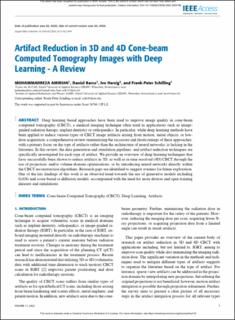Please use this identifier to cite or link to this item:
https://doi.org/10.21256/zhaw-29635| Publication type: | Article in scientific journal |
| Type of review: | Peer review (publication) |
| Title: | Artifact reduction in 3D and 4D cone-beam computed tomography images with deep learning - a review |
| Authors: | Amirian, Mohammadreza Barco, Daniel Herzig, Ivo Schilling, Frank-Peter |
| et. al: | No |
| DOI: | 10.1109/ACCESS.2024.3353195 10.21256/zhaw-29635 |
| Published in: | IEEE Access |
| Issue Date: | Jan-2024 |
| Publisher / Ed. Institution: | IEEE |
| ISSN: | 2169-3536 |
| Language: | English |
| Subjects: | Deep learning; Computed tomography; Artifact; Artificial intelligence |
| Subject (DDC): | 006: Special computer methods 610: Medicine and health |
| Abstract: | Deep learning based approaches have been used to improve image quality in cone-beam computed tomography (CBCT), a medical imaging technique often used in applications such as imageguided radiation therapy, implant dentistry or orthopaedics. In particular, while deep learning methods have been applied to reduce various types of CBCT image artifacts arising from motion, metal objects, or lowdose acquisition, a comprehensive review summarizing the successes and shortcomings of these approaches, with a primary focus on the type of artifacts rather than the architecture of neural networks, is lacking in the literature. In this review, the data generation and simulation pipelines, and artifact reduction techniques are specifically investigated for each type of artifact. We provide an overview of deep learning techniques that have successfully been shown to reduce artifacts in 3D, as well as in time-resolved (4D) CBCT through the use of projection- and/or volume-domain optimizations, or by introducing neural networks directly within the CBCT reconstruction algorithms. Research gaps are identified to suggest avenues for future exploration. One of the key findings of this work is an observed trend towards the use of generative models including GANs and score-based or diffusion models, accompanied with the need for more diverse and open training datasets and simulations. |
| URI: | https://digitalcollection.zhaw.ch/handle/11475/29635 |
| Fulltext version: | Accepted version |
| License (according to publishing contract): | CC BY 4.0: Attribution 4.0 International |
| Departement: | School of Engineering |
| Organisational Unit: | Centre for Artificial Intelligence (CAI) Institute of Applied Mathematics and Physics (IAMP) |
| Published as part of the ZHAW project: | AC3T – AI powered CBCT for improved Combination Cancer Therapy |
| Appears in collections: | Publikationen School of Engineering |
Files in This Item:
| File | Description | Size | Format | |
|---|---|---|---|---|
| 2024_Amirian-etal_Artifact-reduction-with-deep-learning_IEEE_AAM.pdf | Accepted Version | 5.24 MB | Adobe PDF |  View/Open |
Show full item record
Amirian, M., Barco, D., Herzig, I., & Schilling, F.-P. (2024). Artifact reduction in 3D and 4D cone-beam computed tomography images with deep learning - a review. IEEE Access. https://doi.org/10.1109/ACCESS.2024.3353195
Amirian, M. et al. (2024) ‘Artifact reduction in 3D and 4D cone-beam computed tomography images with deep learning - a review’, IEEE Access [Preprint]. Available at: https://doi.org/10.1109/ACCESS.2024.3353195.
M. Amirian, D. Barco, I. Herzig, and F.-P. Schilling, “Artifact reduction in 3D and 4D cone-beam computed tomography images with deep learning - a review,” IEEE Access, Jan. 2024, doi: 10.1109/ACCESS.2024.3353195.
AMIRIAN, Mohammadreza, Daniel BARCO, Ivo HERZIG und Frank-Peter SCHILLING, 2024. Artifact reduction in 3D and 4D cone-beam computed tomography images with deep learning - a review. IEEE Access. Januar 2024. DOI 10.1109/ACCESS.2024.3353195
Amirian, Mohammadreza, Daniel Barco, Ivo Herzig, and Frank-Peter Schilling. 2024. “Artifact Reduction in 3D and 4D Cone-Beam Computed Tomography Images with Deep Learning - a Review.” IEEE Access, January. https://doi.org/10.1109/ACCESS.2024.3353195.
Amirian, Mohammadreza, et al. “Artifact Reduction in 3D and 4D Cone-Beam Computed Tomography Images with Deep Learning - a Review.” IEEE Access, Jan. 2024, https://doi.org/10.1109/ACCESS.2024.3353195.
Items in DSpace are protected by copyright, with all rights reserved, unless otherwise indicated.